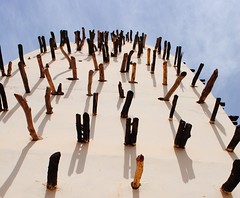After ten minutes of sensitive negotiation a small and rather hole ridden pirogue rolled onto the sandy shore of the River Niger. We climbed tentatively over its tall sides that rocked wildly as we moved through its long body. Staggering to sit ourselves down on the wood-plank seats we couldn’t help but feel it had been Olivier’s Bambara negotiations that had got us such an exclusive view. As we Bobbed our way around the stage of Festival sur le Niger, the lights of the other lanterns twinkled orange, red and gold. While the sounds of Oumar Koita’s band drifted over the water and the crowd struggled to the front, we cruised happily towards the stage.
 Lighting cotton balls in lanterns in preparation for our pirogue and its twinklely voyage
Lighting cotton balls in lanterns in preparation for our pirogue and its twinklely voyage



The Festival organisation was pretty impressive; local crafts stalls with artisan work from all over West Africa, draconian wrist band control from men in high-visibilty vests and, the wonderful navy of lantern lit boats every night- simply to decorate the River Niger. It all seemed rather extravagant for the normally quite modest Mali. But the Festival provided a showcase for the rich and colourful culture of this region, and being the largest Festival in West Africa it did great justice to its objective.


After a minor boat fire we returned to the shore for the last of the evenings music and as we finished our wonderful holiday in Segu we reflected with other musical friends on the challenge that lay ahead of our project. Given the high quality and incredible musicianship both at the festival and within the band we are lucky enough to be working with we found ourselves feeling a little daunted by the new week of rehearsals.
It seemed we were right to feel a bit overwhelmed. When rehearsals arrived on Monday we realised just how much work we had before us.
“But with music, anything is possible.” Andra spoke with a reassuring wisdom that gave us both the confidence we needed. Concerned we might be forcing a western style on our fellow musicians Andra once again brought wisdom and encouragement to our discussions.

“I’m not interested in African styles, or European styles… Music is music and that’s what I’m interested in.”
And so, as our work multiplies and the challenges become greater we really begin to understand just how much we will learn here. For all of these realisations we have, we sometimes still make mistakes and get it wrong. But sometimes you have to get it wrong in order to get it right. And that, in itself, is quite exciting.









